Introduction
Distagon T18mm f/3.5
CANON MOUNT
This very-wide-angle prime lens reaches its best DxOMark Score (150 Lux – 1/60th exposure time) and its best mid-light scores (5000 Lux – 1/125th) at f/5.6 in both cases. Its very wide angles combined with its good performance make it a suitable lens for landscape and architecture shooting. Mounted on an APS-C body, the crop factor of the sensor makes this 18mm a bit longer (28.8mm) and suitable for reportage as well as for landscape shooting.
On a full-frame sensor (EOS 1Ds MkIII):
This 18mm delivers a very good resolution with 51lp/mm, and a rather restrained distortion measured at 0.4%, which is quite good for such a wide-angle lens. Its biggest weaknesses is light transmission above 4 T-stops (certainly derived from its complex optical formula), and quite pronounced LCA limited to the sides of the map between f/3.5 and f/5.6, but invading a much bigger area at f/8 and higher.
The best resolution is achieved between f/3.5 and f/11. Wide open, its center is already very sharp. Stopping down to f/5.6 delivers a highly detailed central zone (up to one-third of the map), with the next one-third being very good too (above 50lp/mm). Stopping down to f/11 will make the last one-third of the map and the angles much better.
Vignetting is quite important wide open, mostly in the corners. At f/5.6, things are much better, but no matter the aperture, the vignetting is always noticeable.
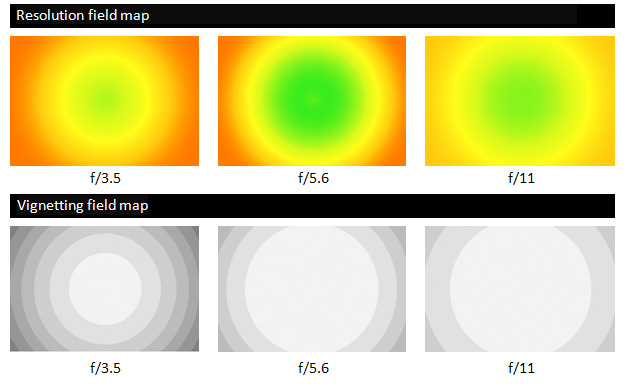
On an APS-C sensor (EOS 7D)
Mounted on an APS-C sensor, the behavior is similar. The resolution decreases a bit, which is normal. Although the map looks similar to that of the full-frame sensors, the best definition is found between f/5.6 and f/8, where it remains above 50lp/mm on most of the map, except for on the edges; but the overall homogeneity is quite good.
Reducing the sensor size always has a very strong impact on vignetting. If it was important on a 24×36 sensor, on this sensor it is halved, and much easier to handle even at full aperture. At f/5.6, vignetting simply disappears.
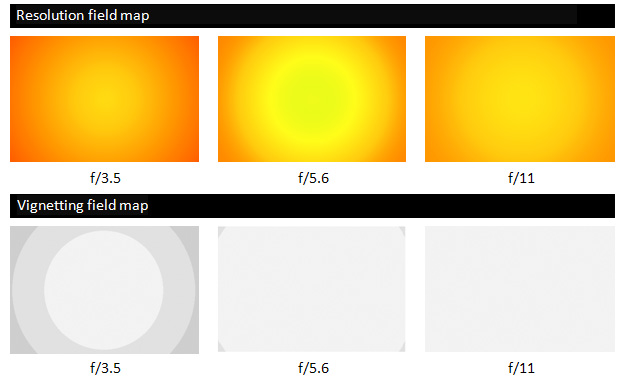
Comparison:
Zeiss Distagon T 18mm f/3.5 ZE Canon v. Canon EF 16-35mm f/2.8L II USM
NIKON MOUNT
Mounted on a Nikon body, this lens achieves its best low-light and mid-light scores at f/4, except for the mid-light score on an APS-C sensor (achieved at f/5.6).
The strength of this wide-angle lens is clearly its reduced distortion (0,7% on a full-frame and 0,5% on an APS-C); on the other hand, chromatic aberrations are pronounced, especially on the last one-third of the field when mounted on an APS-C sensor, and its resolution may not be as high as expected.
On a full-frame sensor (D3X):
Associated with a full-frame sensor, this 18mm provides a sharp central zone at full aperture. Stopping down to f/5.6 makes this central area wider, making the whole first one-third clear and sharp. But the corners remain much softer. At f/8 they are degraded, but improve again at f/11.
Vignetting is quite visible at f/3.5, but gradually diminishes when the lens is stopped down. But although it is easily manageable, it never totally disappears.
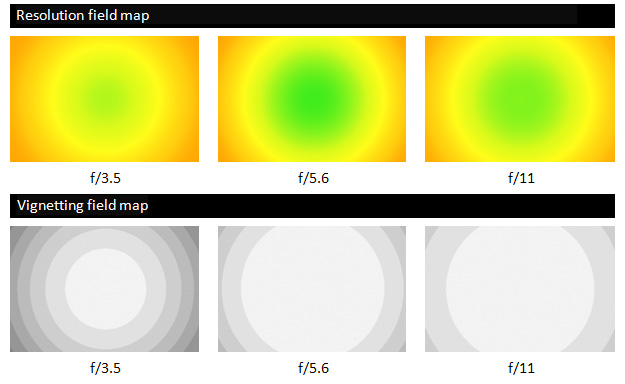
On an APS-C sensor (D300s):
On an APS-C body, this wide-angle lens is not as good as it was on full-frame. When fully opened, most of the field map is soft. Stopping down to f/5.6 and f/8, and even f/11, makes the center much better, but the last one-third of the map remains softer.
Vignetting here is not a real problem. Noticeable at full aperture, it almost disappears when stopped down to f/5.6, leaving only the corners a bit darker.
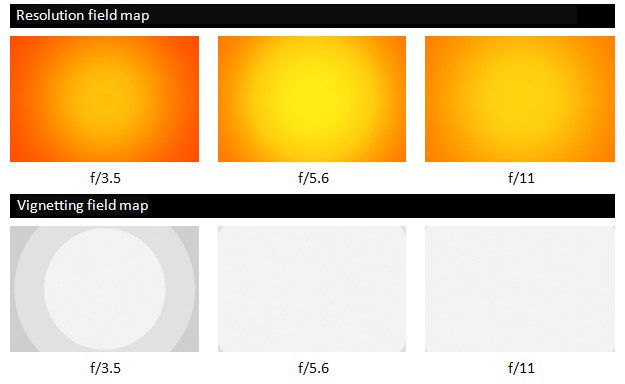
Comparison:
Zeiss Distagon T18mm f/3.5 ZF2 v. Nikkor AF-S 17-35mm f/2.8D IF-ED
Distagon T21mm f/2.8
CANON MOUNT
This 21mm f/2.8 lens achieves its best DxOMark Score at f/2.8. If its resolution is not as high as many other Zeiss lenses, it remains solid both on full-frame and on APS-C sensors. Its most noticeable advantages are, here again, rather limited distortion for a wide angle lens, and very few chromatic aberrations. As with many wide angle lenses, this 21mm proves a solid companion for landscape both on APS-C and 24×36 sensors, and can also be used for reportage when mounted on an APS-C body.
On a full-frame sensor (EOS 1Ds MkIII):
On a full-frame sensor the resolution map is very sharp from the center to the first one-third, even fully opened. Stopping down to f/4 makes the same center to one-third of field even crisper; but as soon one reaches f/5.6, even if the center remains crisp, the last third and the corners become very soft. The best aperture range for this lens is definitely located between f/2.8 and f/4.
Vignetting is quite pronounced at wide apertures, but at f/5.6 and onwards it becomes almost anecdotic.
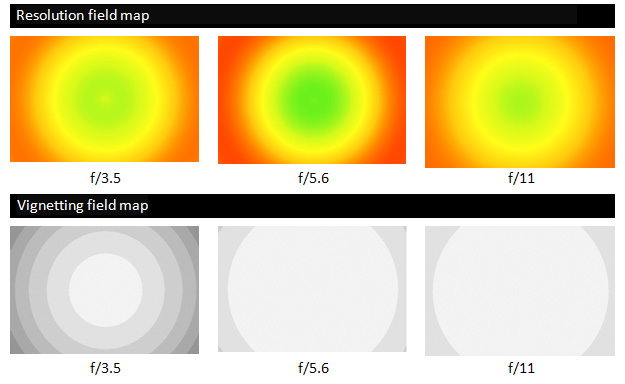
On an APS-C sensor (EOS 7D)
The behavior of this 21mm mounted on an APS-C body is almost identical with its behavior on a full-frame, as far as definition is concerned. The center is correct fully opened. Stopping down to f/5.6 will produce a very sharp zone on two-third of the map, but the last one-third and the corners always remain much softer. Closing to f/8 and smaller reduces the size of the central sharp area. Here the best aperture range is located between f/4 (where the map is the the most regular) and f/5.6.
If vignetting is visible at f/2.8, it vanishes two steps further. As soons as one reaches f/5.6, the map in perfect.
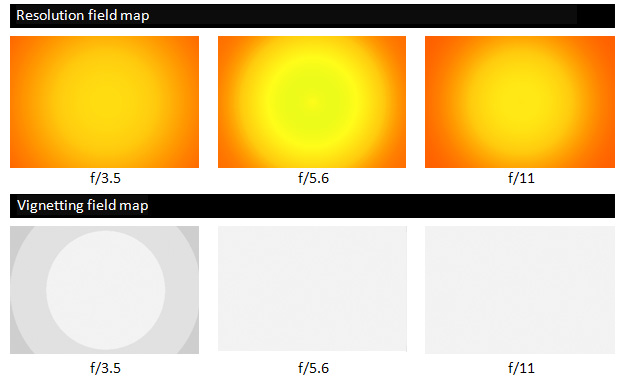
Comparison:
Zeiss Distagon T 21mm f/2.8 ZE Canon v. Canon EF 16-35mm f/2.8L II USM
Distagon T25mm f/2.8
NIKON MOUNT
This lens is really sharp. But reading its metrics without digging in a bit more is misleading. At first sight one may think that the level of chromatic aberration is huge—25 µm is quite an important figure. But as explained earlier, its location on the field map makes it suddenly almost inconsequential. Nearly the whole field is perfect, except in the extreme corners, which are quite degraded. But this is really limited to a tiny external portion of the field, whereas when mounted on a APS-C sensor, this very same phenomenon occupies a bigger part of the frame, but still limited at 7 µm. Curiously enough, this time, 25 µm may be preferable to 7 µm.
The behavior of this lens, coupled with its focal length, make it a very good choice for landscape shooting and also for reportage when associated with an APS-C sensor with a 1.5x crop factor.
Its best DxOMark low-light performance score (150 Lux – 1/60th) is achieved at f/4, whereas for the best mid-light performance (5000 Lux – 1/125th), the lens has to be stopped down to f/5.6.
On a full-frame sensor (D3X):
Full aperture delivers a good central zone, representing a good first one-third of the frame. But the remaining portion lies between 20 and 30 lp/mm. Stopping down to f/5.6 makes this same area much sharper, and the second one-third of the frame quite good, standing above 50lp/mm. Only the corners remain soft. At f/11 these corners manage to reach 50lp/mm, although the central zone softens a bit (but still remaining quite sharp).
Vignetting is very pronounced a full aperture. Stopping down to f/5.6 and smaller improves things a lot, and only the last one-third of the map remains 1/3 EV darker, which is easy to compensate for.
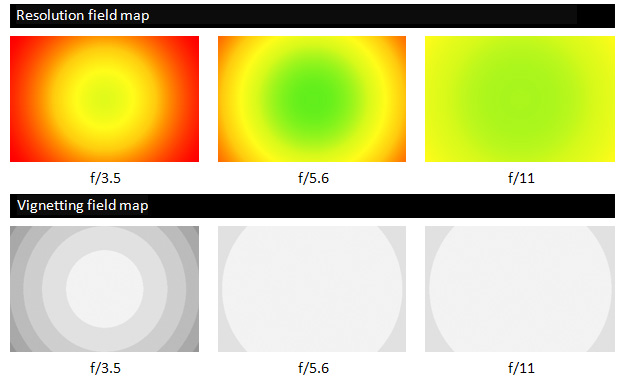
On an APS-C sensor (D300s):
Full aperture delivers a very soft image, with the whole frame showing a resolution below 40lp/mm. Stopping down to f/4 improves things in the center, but going to f/5.6 and f/8 makes it even better with two-thirds of the field achieving above 50lp/mm. Closing to f/11 again reduces the resolution.
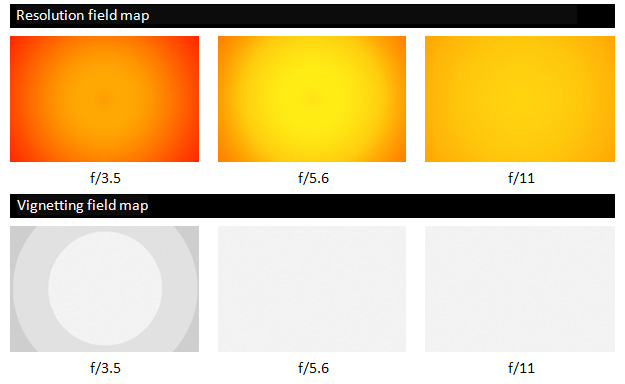
Vignetting is quite visible when the lens is fully opened, but completely disappears as soon as the lens is stopped down to f/4 or smaller apertures.
Comparison 1:
Zeiss Distagon T25mm f/2.8 ZF2 v. Nikkor AF-S 17-35mm f/2.8D IF-ED
Comparison 2:
Zeiss Distagon T25mm f/2.8 ZF2 v. Nikkor AF-S 24mm f/1.4G ED
Distagon T28mm f/2
CANON MOUNT
This wide angle prime is one of the sharpest Zeiss lenses we tested. Its best DxOMark score (Low light – 150 Lux – 1/125th) is achieved at f/4 on both full-frame and APS-C sensors. This lens is a very good companion for reportage and landscape uses, and can even be suitable for portraits on an APS-C body.
Sharp and balanced, this lens behave particularly well coupled with an APS-C sensor, where it produces slightly less chromatic aberration, distortion, and vignetting. But it remains a very strong performer on a full-frame sensor as well.
On a full-frame sensor (EOS 1Ds MkIII):
On a full-frame sensor, the resolution field map is above 50lp/mm on two-thirds of the field. The edges are a bit softer, but this is rather harmonious. Closing by 1 stop makes the center particularly sharp, but you have to close to 2 stops beyond, to f/5.6, to have both a sharp center and very good edges. At f/8, the very good central zone expands to the entire first one-third; but at f/11, the center becomes much softer. The best resolution is thus achieved between f/5.6 and f/8.
Vignetting is rather important fully opened, but almost forgotten at f/5.6 and beyond.
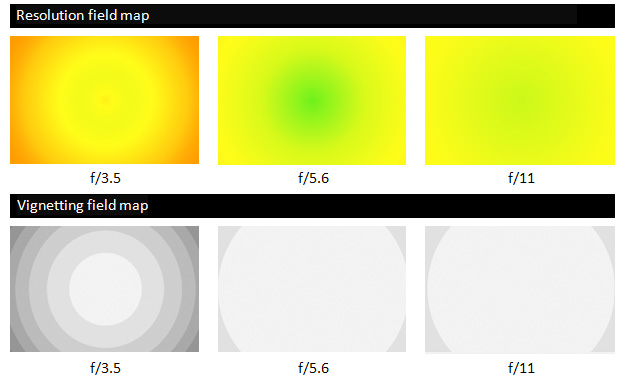
On an APS-C sensor (EOS 7D)
Mounted on an APS-C sensor, this 28mm proves quite sharp as soon as f/4, which is the aperture providing the best resolution on the whole map. Stopping down to f/5.6 and f/8 keeps the middle sharp, but smoothes the edges. F/11 and smaller apertures are not as sharp, losing up to 10lp/mm on the whole field map.
Vignetting handling is quite well here. Visible at full aperture, it completely vanishes at f/2.8.
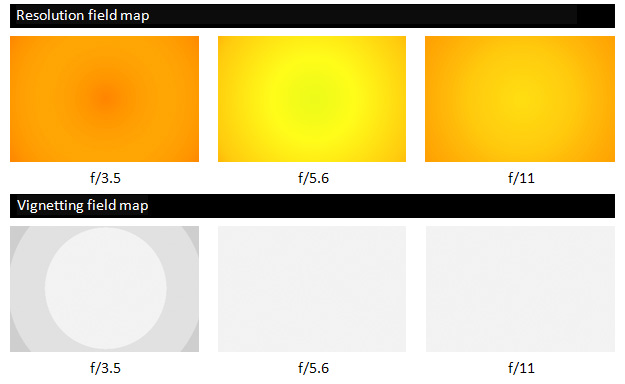
Comparison:
Zeiss Distagon T 28mm f/2 ZE Canon v. Canon EF 16-35mm f/2.8L II USM
NIKON MOUNT
With a resolution reaching 60lp/mm on a D3x, this lens proves extremely sharp. As often on the Zeiss lenses the chromatic aberrations are limited to the outer fringe of the map, leaving a perfectly handled frame. In this case this is true on a full-frame sensor; on an APS-C body however, this LCA phenomenon is really discrete and imperceptible at f/4 and smaller apertures.
This 28mm achieves its best DxOMark low-light performance at f/2.8 on both full-frame and APS-C sensors, which is good enough for a fast lens. The mid-light best performance is found at f/4.
This lens is thus very good for landscape shooting on a full-frame body as well as on an APS-C; on the latter, the crop factor helps to make it a very nice lens for reportage, too.
On a full-frame sensor (D3X):
Fully opened, the lens provides a good enough frame, mostly above 50lp/mm, except for the edges. At f/2.8, the middle climbs above 60lp/mm and at f/5.6, the central two-thirds of the field are sharp, while the edges climb above 50lp/mm.
Vignetting is important when the lens is opened wide, but stopping down gradually decreases the loss of light, and at f/5.6 the loss is already inferior to one-third EV. The pattern does not improve at smaller apertures.
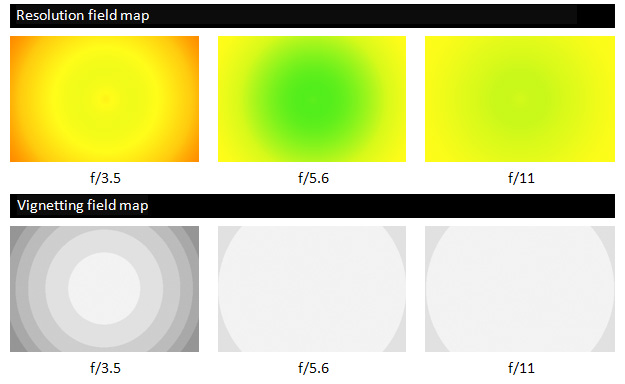
On an APS-C sensor (D300s):
On an APS-C sensor, the full aperture provides a soft frame. Stopping down to f/4 improves the center a lot, and things remain constant until f/8 is reached, when the edges are softened a bit. F/8 is the upper limit if you are looking for the best resolution.
Vignetting is important here, too, when the lens is wide open, but as soon it is stopped down to f/2.8, only the corners are one-third EV darker. At f/4, vignetting is no longer visible.
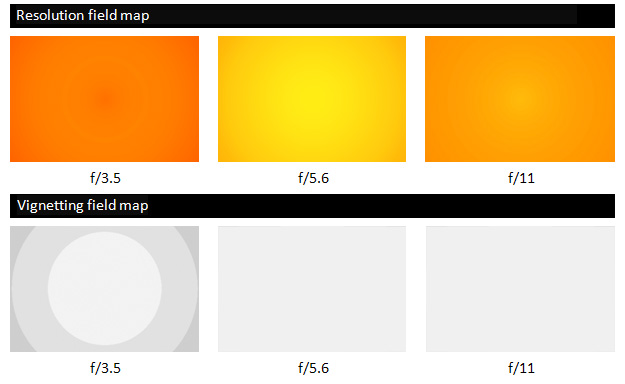
Comparison 1:
Zeiss Distagon T28mm f/2.8 ZF2 v. Nikkor AF-S 17-35mm f/2.8D IF-ED
Comparison 2:
Zeiss Distagon T28mm f/2.8 ZF2 v. Nikkor AF-S 24mm f/1.4G ED
Distagon T35mm f/2
NIKON MOUNT
Mounted on an APS-C sensor, this lens is very good for shooting portraits or for reportage. On a full-frame body, it is a solid lens for landscape as well as for reportage.
Interestingly, it reaches its best low-light DxOMark Score as soon as f/2 on an APS-C sensor, and at f/2.8 on a full-frame. These figures are significant, especially when dealing with a fast lens.
The mid-light performance achieves its best score at f/2.8 on a full-frame, but on an APS-C, the lens needs to be stopped down to f/4.
On a full-frame sensor (D3X):
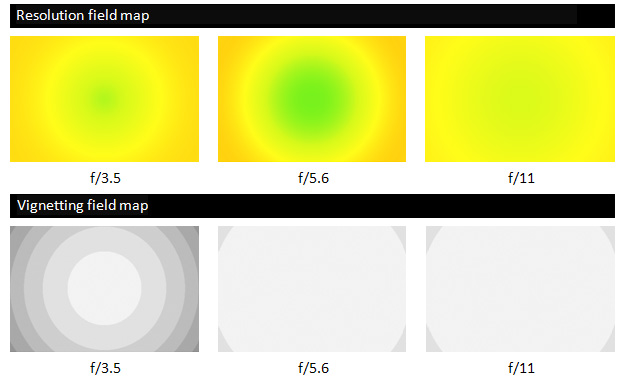
Fully opened, this 35mm offers an interesting field map, the center being already sharp, and most of the frame standing around 50lp/mm. The more interesting being that the corners are almost as sharp as the rest of the field. Stopping down the lens to f/5.6 will increase the size of the sharper central zone without degrading the borders, but without improving them, either.
Vignetting is important at f/2, but it decreases as long as the lens is stopped down. Vignetting becomes limited to the corners at f/5.6.
On an APS-C sensor (D300s):
On a smaller sensor size, the resolution behaves identically, except that the D300s’s 12-megapixel sensor struggles to keep the edges above 40lp/mm. Here again, the optimal range is located between f/2.8 and f/5.6.
Vignetting is noticeable at f/2 but completely disappears as soon as the lens is stopped down to f/2.8 or smaller apertures.
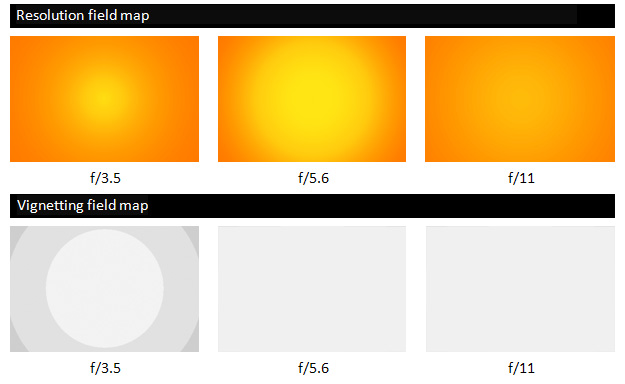
Comparison 1 (On D3x):
Zeiss Distagon T35mm f/2 ZF2 v. Nikkor AF-S 17-35mm f/2.8D IF-ED
Comparison 2 (On D300s):
Zeiss Distagon T35mm f/2 ZF2 v. Nikkor AF-S DX 35mm f/1.8G
Makro Planar T 50mm f/2
CANON MOUNT
This lens belongs to the same Makro-Planar family as the 100mm we have also examined, and it is as reliable as the 100mm.
Sharp, it is gifted with very good light transmission, the T value being almost equal to the F value. Here again, this is a lens showing very little distortion, little vignetting and almost no chromatic aberration when coupled with an APS-C sensor.
It achieves its best DxOMark low-light score at f/2 on an EOS 7D, and f/2.8 on full-frame body.
Logically, this 50mm is a wonderful lens for portraits on both APS-C and full-frame sensors. On a full-frame body, again, this 50mm is very versatile, proving quite good for landscape shooting, and excellent for reportage.
On a full-frame sensor (EOS 1Ds MkIII):
The Makro-Planar T 50mm f/2 ZE has an extremely sharp center (above 60lp/mm) from f/2.8 to f/8. Closing to f/8 widens the central very sharp zone, but the edges always remain good. Beyond f/8, the center of the field map is softened and loses definition.
Vignetting is noticeable when the lens is fully opened, but stopping down to f/4 makes it disappear.
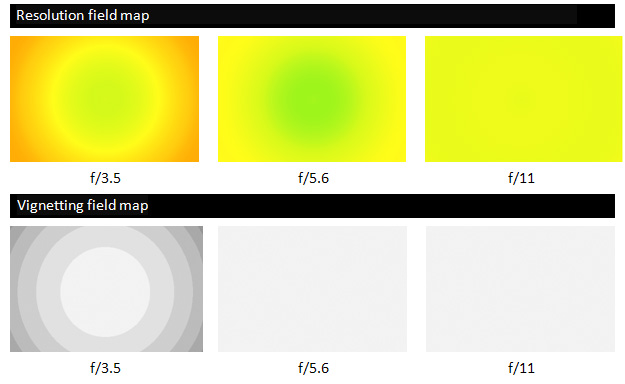
On an APS-C sensor (EOS 7D)
On an APS-C sensor, the definition is quite good fully opened, although the edges are much softer. Stopping down to f/2.8 makes the resolution much more regular: at f/5.6 the field is good everywhere on the map, and above 50lp/mm.
Vignetting isn’t a problem as soon as the lens is stopped down to f/2.8.
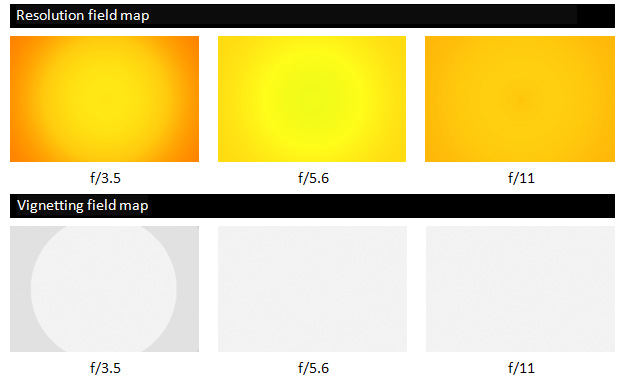
Comparison 1:
Zeiss Makro Planar T 50mm f/2 ZE Canon v. Canon EF 50mm f/1.4 USM
Comparison 2:
Zeiss Makro Planar T 50mm f/2 ZE Canon v. Canon EF 50mm f/1.2L USM
NIKON MOUNT
Good for portraits, reportage and landscapes when mounted on a full-frame body, this 50mm is very sharp, produces very few chromatic aberrations, and shows almost no distortion. Its best low-light performance is achieved at f/2.8, although it has to be stopped down to f/4 on full-frame and to f/5.6 on APS-C to reach its best mid-light score.
On a full-frame sensor (D3X):
Full aperture provides a clear central zone over 50lp/mm, while the edges remain a bit softer. Stopping down the lens gradually improves the center and the sides, but the center is always sharper than the sides.
Vignetting is strong at f/2, but gradually disappears as the lens is stopped down. At f/4, only the corners are darker, and at f/5.6, vignetting is gone.
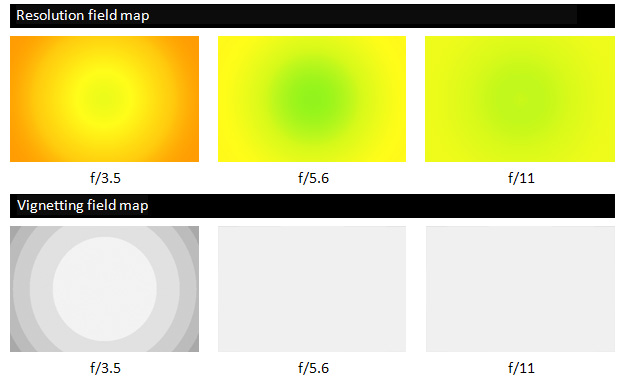
On an APS-C sensor (D300s):
On a smaller sensor, the scenario is almost the same, except that one has to stop down the lens to f/5.6 to achieve the best resolution for this lens. Wider apertures show very soft edges.
Visible on the external one-third of the field when the lens is wide opened, vignetting simply disappears 1 stop later and at f/2.8, it is invisible.
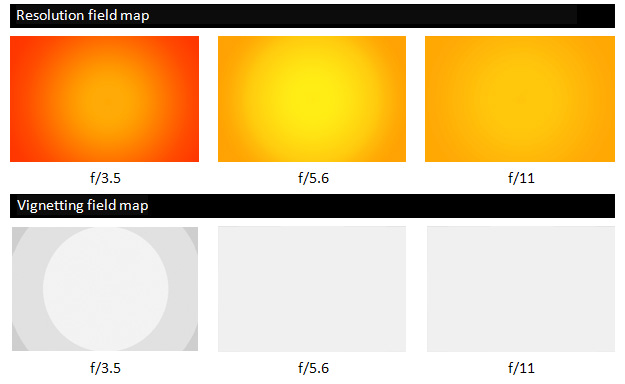
Comparison 1:
Zeiss Makro Planar T 50mm f/2 ZF2 v. Nikkor AF 50mm f/1.4D
Comparison 2:
Zeiss Makro Planar T 50mm f/2 ZF2 v. Nikkor AF 50mm f/1.8D
Comparison 3:
Zeiss Makro Planar T 50mm f/2 ZF2 v. Nikkor AF 50mm f/1.4G
Planar T50mm f/1.4
NIKON MOUNT
This 50mm reaches its best DxOMark low-light score at f/2.8 on both APS-C and full-frame sensors, and has to be stopped down to f/4 to achieve its best mid-light score.
This makes this 50mm a suitable candidate for portraits or reportage.
Distortion is handled well, as well as chromatic aberrations are on full-frame; these perturbations are slightly more noticeable on the edges when the lens is attached to a D300s, for instance. The biggest concern with this very fast lens is that it is hardly usable at its maximum aperture and has to be stopped down by 2 stops to reach a good enough definition.
On a full-frame sensor (D3X):
When installed on a D3x, the first noticeable detail is that opening the lens wide results in strongly deteriorated resolution, between 20 and 30lp/mm on the whole frame. The central first one-third becomes interesting when the lens is stopped down to f/2.8, and becomes very sharp at f/4and f/5.6. But the edges remain much softer. To improve them, one must stop down to f/11, thus lowering the resolution in the middle of the field.
Visible at f/1.4, vignetting disappears as soon as the lens is stopped down to f/2.8.
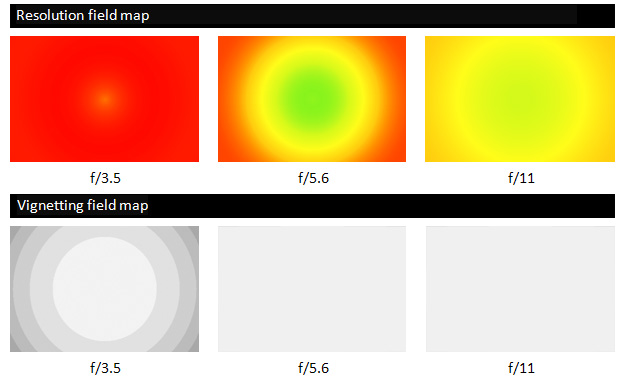
On an APS-C sensor (D300s):
On a smaller-sized sensor, the resolution behaves the same way: very poor when the lens is wide open, it improves considerably when stopping down to f/4 and f/5.6, but the last one-third of the field remains very soft.
At full aperture, vignetting is present, although quite light; 1 stop later, at f/2, it has completely disappeared.
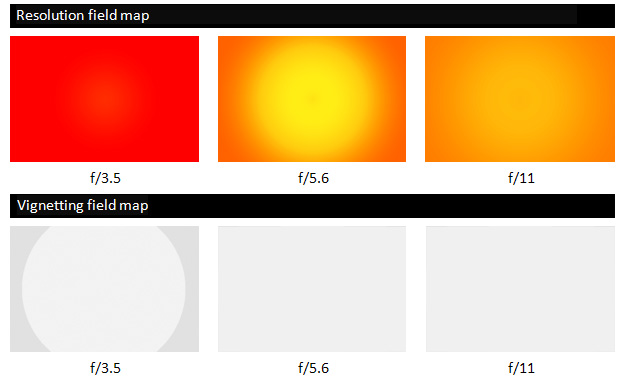
Comparison 1:
Zeiss Planar T 50mm f/1.4 ZF2 v. Nikkor AF 50mm f/1.4D
Comparison 2:
Zeiss Planar T 50mm f/1.4 ZF2 v. Nikkor AF 50mm f/1.8D
Comparison 3:
Zeiss Planar T 50mm f/1.4 ZF2 v. Nikkor AF 50mm f/1.4G
Planar T 85mm f/1.4
CANON MOUNT
The 85mm f/1.4 ZE has a remarkable light transmission capacity. But transmitting light is not everything, and this lens has the same problem on both APS-C and full-frame sensors: it is very soft at wider apertures—but only at widest ones, since stopping down a little bit changes everything.
This is rather well summed up by its DxOMark score, showing the best low-light performance of this lens at f/2.8. This will be the key aperture.
The rest is solid: good transmission, no distortion, little vignetting, and a reasonable amount of chromatic aberration contribute to making this 85mm a good candidate for portrait shooting and even for sports on an APS-C, where its focal becomes 136mm.
On a full-frame sensor (EOS 1Ds MkIII):
Everything changes at f/2.8. Opened wider than this, the lens produces a very soft image. Hardly 20lp/mm at f/1.4… this is quite poor. Stopping down to f/2 makes the center better, but still soft. Things seem dull… but when f/2.8 is reached, everything changes. The center is suddenly very sharp, around 60lp/mm, the first one-third is solid, and the edges are almost good. Between f/4 and f/5.6, the whole first one-third is very good, and the rest of the field map stands above 50lp/mm. By the way, this area is the best one for this lens. Stopped down to f/8 and above softens the center, but maintains the field around 50lp/mm.
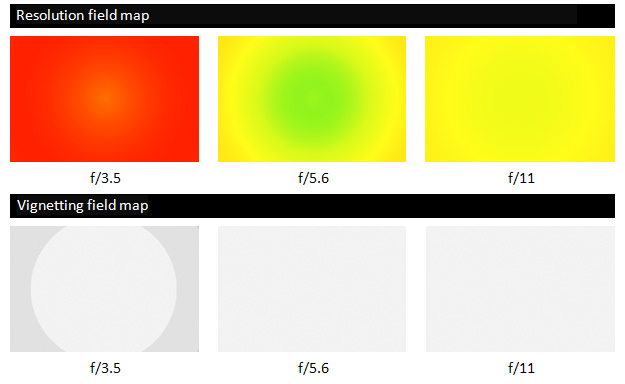
On an APS-C sensor (EOS 7D)
On an APS-C sensor, the scenario is the same. Wider than f/2.8, the lens is not sharp enough. At f/2.8 it suddenly becomes sharp all over the field map, and remains so until stopped down to f/8. Precise and regular.
Vignetting is noticeable, although very light when the lens is fully opened, but vanishes when stopped down to f/2.
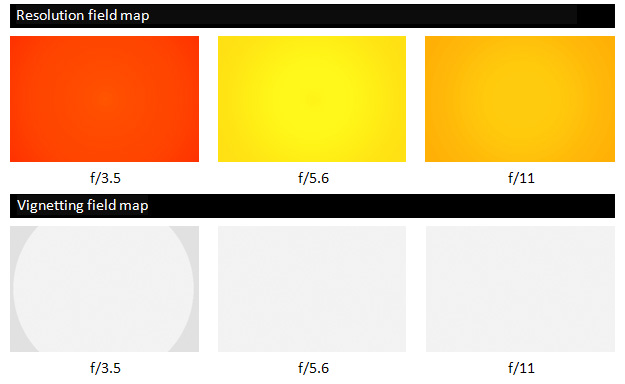
Comparison 1:
Zeiss Makro Planar T 85mm f/1.4 ZE Canon v. Canon EF 85mm f/1.2L USM
Comparison 2:
Zeiss Makro Planar T 85mm f/1.4 ZE Canon v. Canon EF 85mm f/1.8 USM
NIKON MOUNT
This 85mm achieves its best DxOMark low-light score at f/2.8 on both APS-C and full-frame sensors, and its best mid-light score at f/4. Sharp, it produces almost no distortion, limited vignetting, and limited chromatic aberration on the edges of the field.
This is a good companion for portraits, and even for sports, thanks to the crop factor that an APS-C sensor provides.
On a full-frame sensor (D3X):
As with the 50mm we studied earlier, the maximum aperture lacks definition on the whole field and the lens has to be stopped down by 2 stops to offer a central zone above 50lp/mm. At f/4, the center becomes very good, and at f/5.6, the sides of the field rise above 50lp/mm as well.
Vignetting, visible at wide apertures, completely disappears at f/2.8 and smaller apertures.
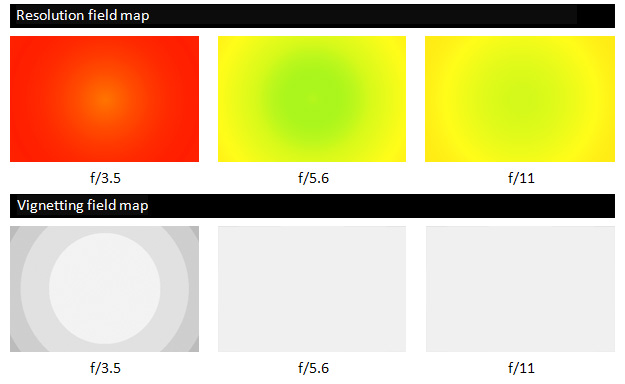
On an APS-C sensor (D300s):
The resolution scenario is very similar here. Very soft when wide open, the lens has to be stopped down to f/4 to reach both its best resolution and to achieve good homogeneity on the whole field.
Already very limited at full aperture, vignetting completely vanishes 1 stop later. At f/2, there is no visible vignetting.
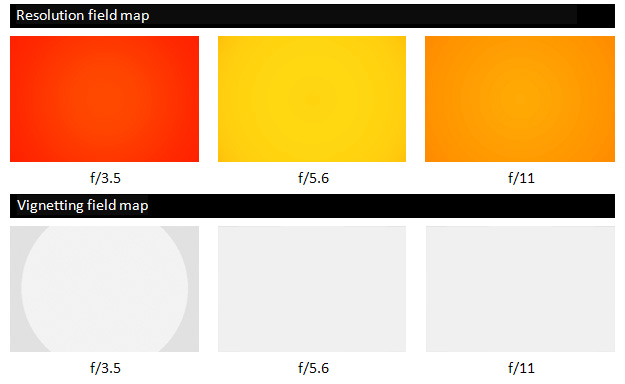
Comparison:
Zeiss Planar T 85mm f/1.4 ZF2 v. Nikkor AF 85mm f/1.4D IF
Makro Planar T 100mm f/2
CANON MOUNT
This macro lens is a really solid competitor. Sharp, it displays very homogenous resolution field maps, shows almost no distortion at all, very little vignetting even on 24×36 sensors, and very few chromatic aberrations. This is a reliable lens, for sure!
It reaches its best DxOMark low-light score at f/2.8 on both sensor types. On a full-frame, it is a remarkable portrait lens that also shows good capability for sports photography. On an APS-C camera, it remains very good for portraits, but proves terrific for sports.
On a full-frame sensor (EOS 1Ds MkIII):
Mounted on an EOS 1Ds MkIII, this 100mm macro is already above 50lp/mm at full aperture. More remarkable, it is perfectly constant on the whole map, even in the corners! Stopping down to f/4 preserves the edges and the corners, but increases the first one-third by more than 10 lp/mm. At f/8 the very sharp zone in the middle has shrunk a bit, and disappears when closed at f/11. The best aperture is f/4. But the edges and the corners are never softer than the rest of the field. Impressive.
Vignetting is visible at f/2, but disappears as soon as the lens is stopped down to f/4. This is really good on a full-frame sensor. Thus at f/4, you have the best resolution and no vignetting.
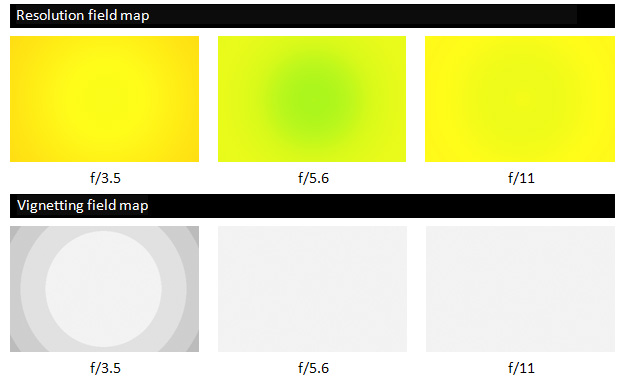
On an APS-C sensor (EOS 7D)
On an EOS 7D, the picture is roughly identical. The resolution is good and particularly regular on the whole field map. The best zone is located between f/4 and f/8, where resolution remains above 50lp/mm everywhere on the field map.
As on a full-frame body, vignetting is noticeable at full aperture, but simply disappears as soon as f/2.8.
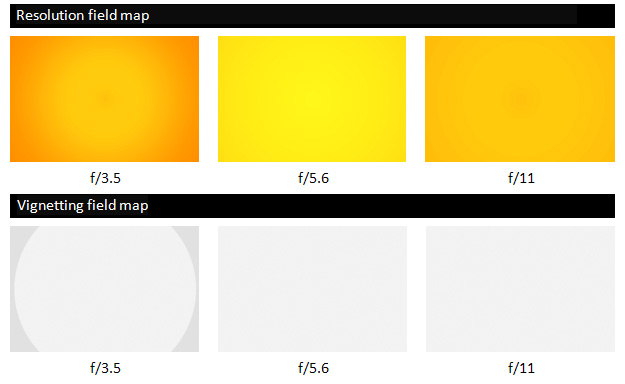
Comparison 1:
Zeiss Makro Planar T 100mm f/2 ZE Canon v. Canon EF 24-105mm f/4L IS USM
Comparison 2:
Zeiss Makro Planar T 100mm f/2 ZE Canon v. Canon EF 85mm f/1.2L II USM
NIKON MOUNT
No distortion, little vignetting, solid resolution, and almost no chromatic aberrations—the overall picture is really exciting. Its low-light score is just as impressive, since this macro lens is at its best even at its wider aperture, and for its mid-light score, when stopped down to f/4. This makes this lens it a very potent candidate for portraits as well as for sports, especially on APS-C sensors.
On a full-frame sensor (D3X):
The wider aperture is already good, providing around 50lp/mm on the whole frame, even in the corners. Stopping down to f/5.6 will improve the center resolution to almost 60lp/mm without degrading the edges.
Although vignetting is important at f/2, it completely disappears when the lens is stopped down to f/4 and beyond.
On an APS-C sensor (D300s):
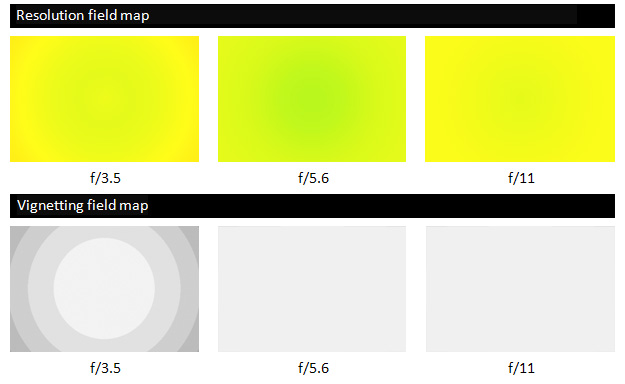
The scenario is similar for APS-C sensors: the whole frame stays very homogenous and the edges are never degraded compared to the middle of the field. Full aperture is a bit soft, but stopping down to f/5.6 will give the best resolution the lens can achieve.
Here again, as it was the case on a full-frame body, the vignetting is visible at maximum aperture but disappears 1 stop later.
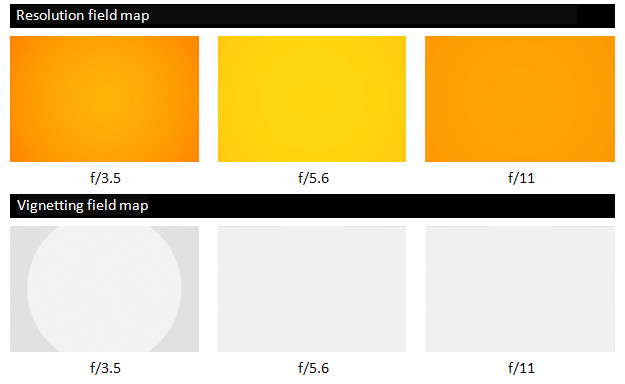
Comparison:
Zeiss Makro Planar T 100mm f/2 ZF2 v. Nikkor AF-S VR 105mm f/2.8G IF-ED


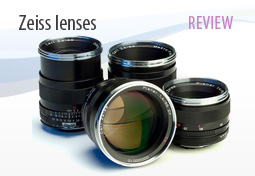
DXOMARK encourages its readers to share comments on the articles. To read or post comments, Disqus cookies are required. Change your Cookies Preferences and read more about our Comment Policy.